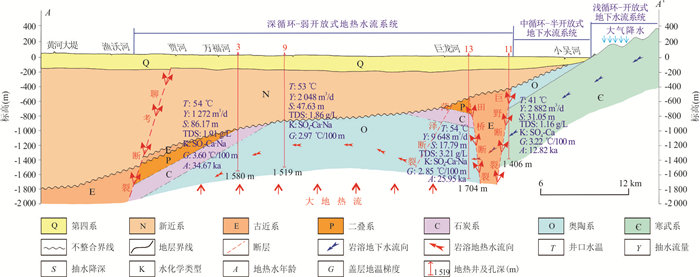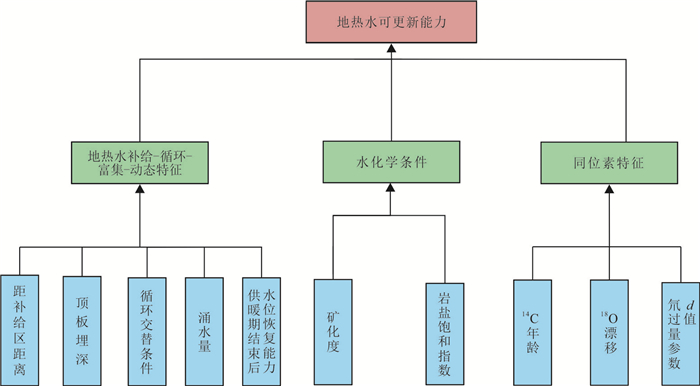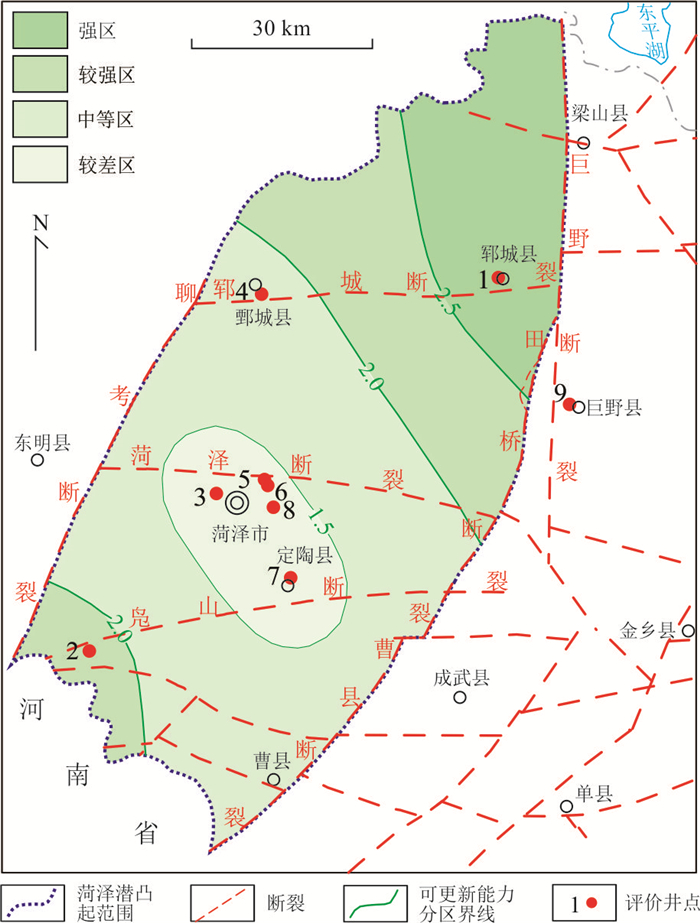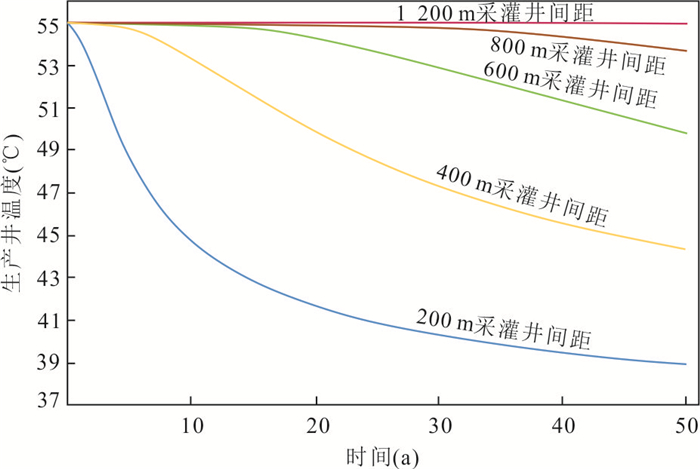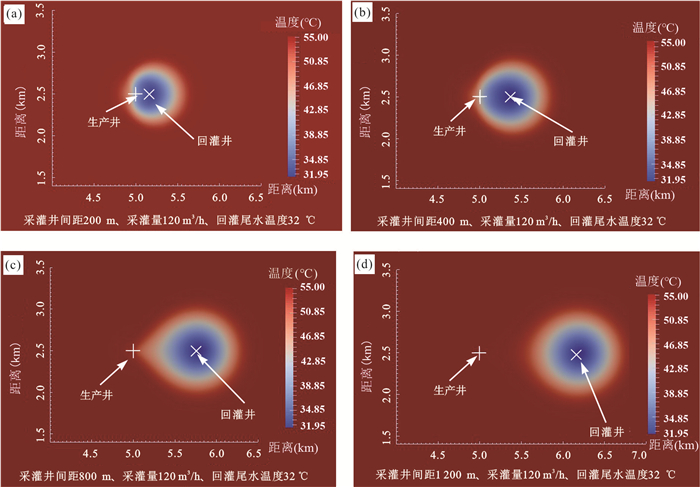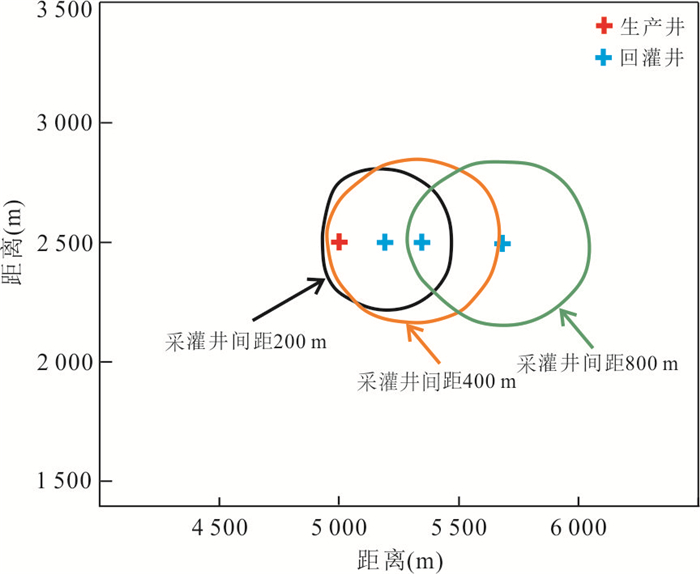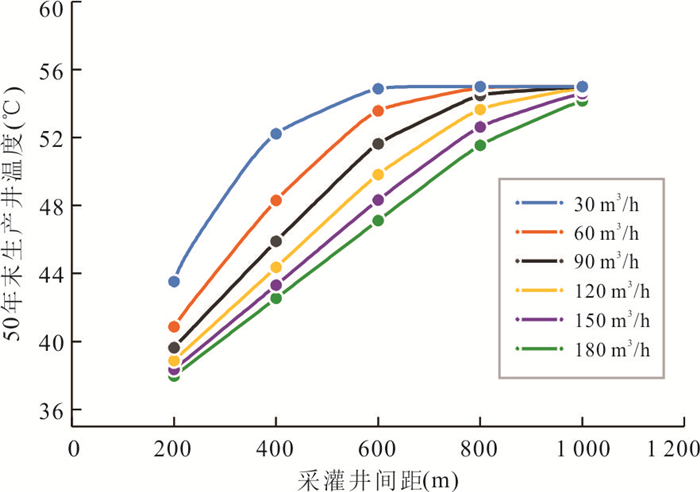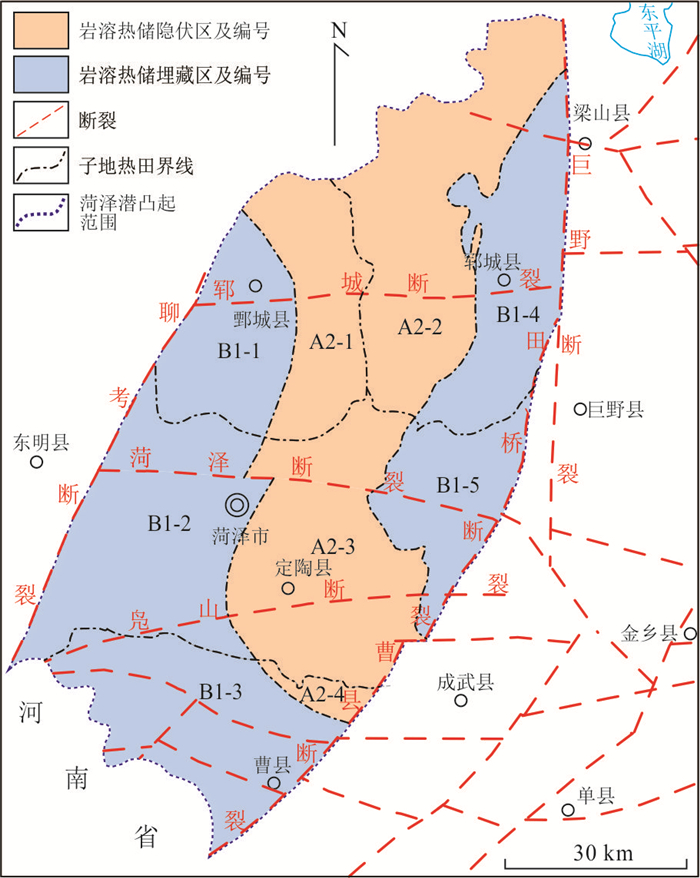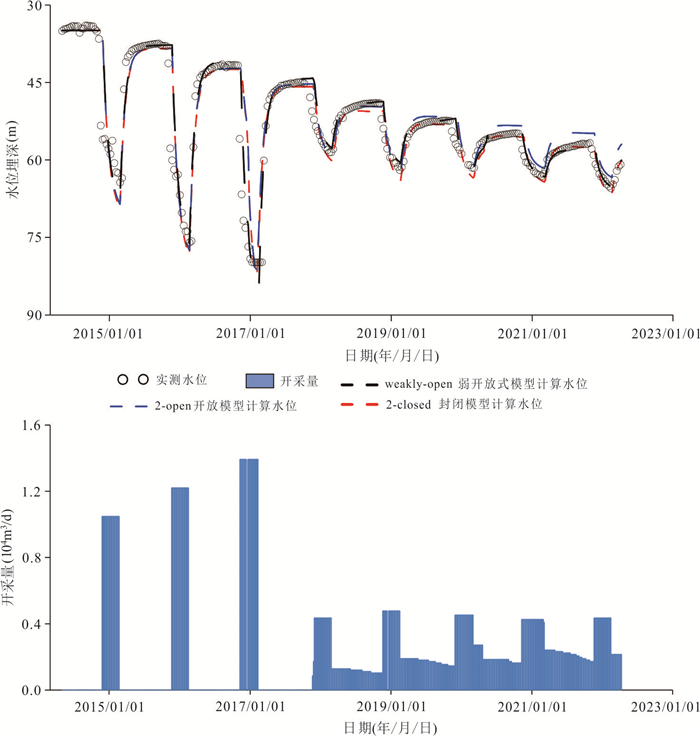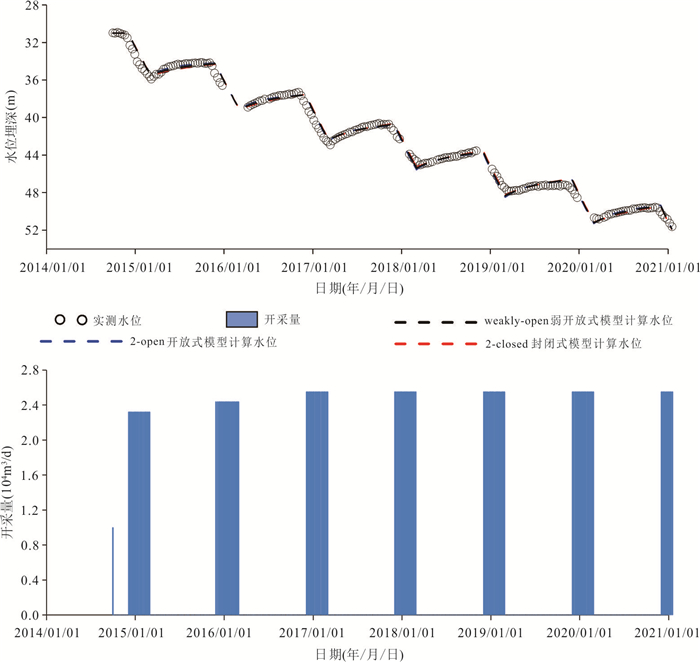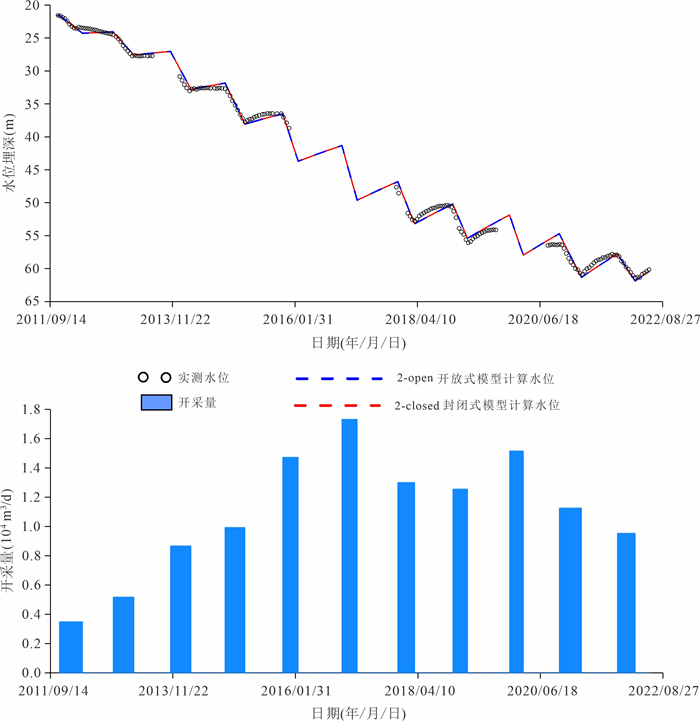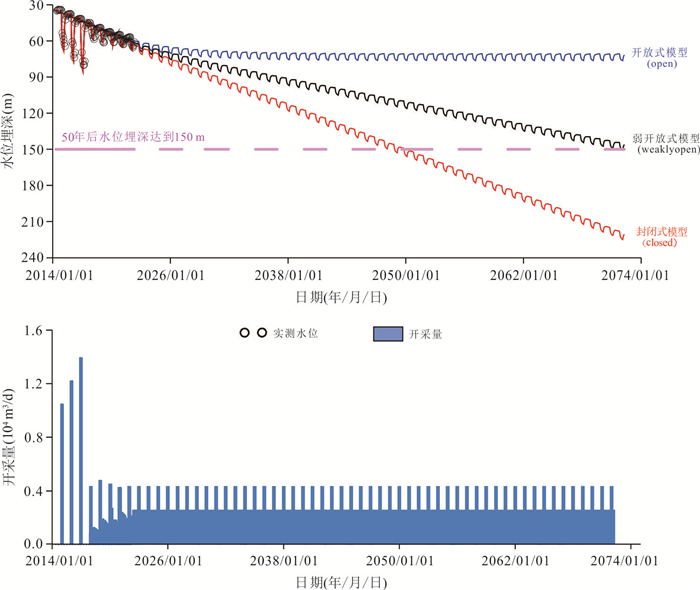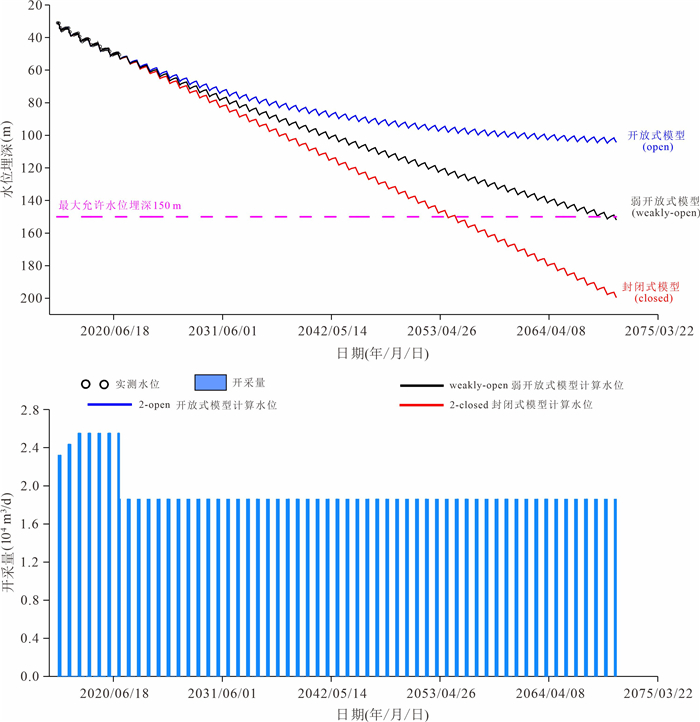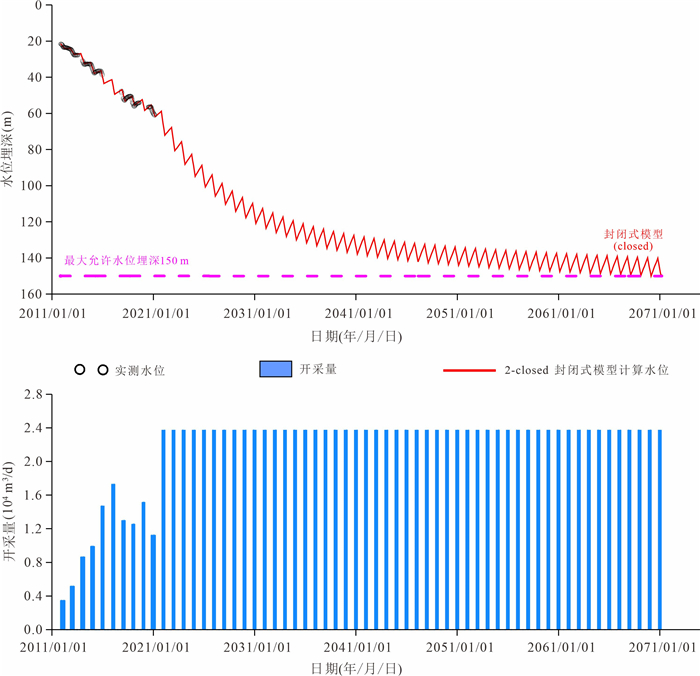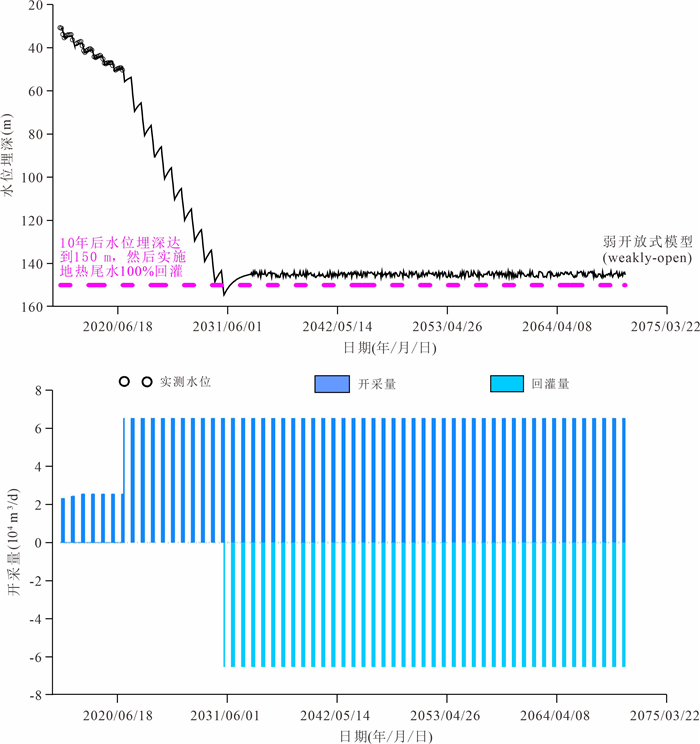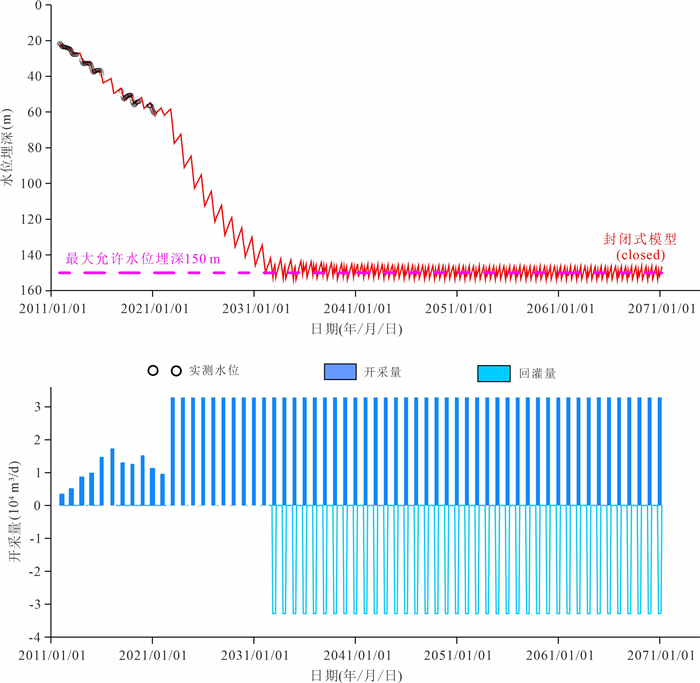Renewable Capacity of Karst Geothermal Water and Production-Reinjection Balanced Resources Evaluation: A Case Study of Heze Buried Uplift Geothermal Fields
-
摘要: 地热水可更新能力及采灌均衡可持续开采量计算评价是地热能可持续开采的关键核心问题.为更科学地开展评价研究,以菏泽潜凸起岩溶热储地热田为例,以地热水循环富集、开采动态、水化学条件、同位素特征等为主控评价因子,建立评价指标体系,综合评价岩溶热储地热资源可更新能力;提出了地热水采灌均衡——保证地热水量均衡和热能均衡条件下可持续开采量的计算方法,评价了地热田集中开采区采灌均衡条件下地热水的可持续开采量.菏泽潜凸起地热田地热水可更新能力分为强、较强、较差和差4个区.强区分布于地热田东北部靠近梁山和嘉祥补给山区一带;差区分布于地热田中南部定陶‒菏泽城区地热水排泄区一带;补给区和断裂带附近裂隙岩溶发育、富水性较好,远离补给区和断裂带的则岩溶发育度程度差、热储富水性差.集中开采区岩溶地热水采灌均衡条件下可持续开采量为122 600 m3/d,是自然条件下的2.49倍.Abstract: The renewable capacity of geothermal water and production-reinjection balanced resources evaluation of karst geothermal fields are the key issues of sustainable exploitation of geothermal energy. In order to evaluate the research more scientifically, this paper takes the Heze buried uplift geothermal field as an example, and takes the cycle enrichment, development dynamics, hydro-chemical and isotope characteristics of geothermal water as the controlling factors to establish an evaluation index system to comprehensively evaluate the renewable capacity of karst reservoir geothermal resources. The calculation method of sustainable yield of geothermal water is put forward under the prerequisite of production-reinjection balance, i.e. under the condition of geothermal water equilibrium and heat energy equilibrium. Then, the sustainable yield of geothermal water in the concentrated exploitation area of the geothermal field is evaluated. The renewability of geothermal water in the Heze buried uplift geothermal field is divided into four districts: strong, relatively strong, medium and poor. The strong region is distributed in the recharge area in the northeastern part of the geothermal field near the Liang mountain and Jiaxiang; the poor region is distributed in the discharge area around Dingtao-Heze urban area in the central and southern part of the geothermal field. In the recharge area and near the fault zones, the fissures and karstifications are developed strongly, and the water abundance of the geothermal reservoir is rich. On the contrary, far away from the recharge area and the fault zones, the fissures and karstifications are developed weakly, and the water abundance is poor. Under the production-reinjection balanced condition, the sustainable yield of geothermal resources is evaluated to be 122 600 m3/d in the concentrated exploitation area, which is 2.49 times as much as under the natural condition.
-
图 1 菏泽潜凸起基岩地质图(据康凤新等,2023修改)
1.古近系;2.白垩系;3.侏罗系;4.石炭系‒二叠系;5.奥陶系;6.寒武系;7.新太古界;8.太古宙侵入岩;9.古元古代侵入岩;10.断裂;11.地层界线;12. 奥陶系灰岩顶板埋深等值线及值(m);13.剖面线及编号;14.菏泽潜凸起岩溶热储分布区
Fig. 1. Geological-structural map of Heze buried uplift (modified by Kang et al., 2023)
图 2 菏泽潜凸起东西向地热地质剖面(据康凤新等,2023修改)
Fig. 2. East-West geothermal geological profile of Heze buried uplift (modified by Kang et al., 2023)
图 13 模拟地热系统的集中参数模型原理示意(据Axelsson,2012修改)
Fig. 13. Schematic diagram of lumped parameter model (modified from Axelsson, 2012)
表 1 评价因子两两比较打分原则
Table 1. Comparison and scoring principles of evaluation factors
标度 含义 1 表示两个要素相比,具有相同重要性 3 表示两个要素相比,前者比后者稍重要 5 表示两个要素相比,前者比后者明显重要 7 表示两个要素相比,前者比后者强烈重要 9 表示两个要素相比,前者比后者极端重要 2, 4, 6, 8 表示上述相邻判断的中间值 倒数 若要素i与要素j的重要性之比为aij,那么要素j与i重要性之比为:aji=1/aij 表 2 各要素权重计算结果
Table 2. Calculation results of weight of each element
序号 因子 权重 1 距补给区距离 0.189 7 2 矿化度 0.292 0 3 14C年龄 0.108 3 4 循环交替条件 0.179 2 5 顶板埋深 0.051 0 6 18O漂移 0.018 2 7 涌水量 0.050 0 8 氘过量参数d值 0.015 0 9 岩盐饱和指数 0.041 7 10 供暖期结束后水位恢复能力 0.054 7 表 3 地热水可更新能力综合评价各评价因子取值标准
Table 3. Value standard of each evaluation factor for comprehensive evaluation of renewable capacity of geothermal water
评价因子 单项分值 距补给区距离(km) 循环交替条件 热储顶板埋深(m) 涌水量(m3/d) 供暖后水位恢复能力(m) 矿化度(g/L) 岩盐饱和指数 14C年龄(a) 18O漂移 2H过量参数d值 取值标准说明 3 < 30 好 < 900 > 4 000 > 10 < 3.5 < ‒2 < 10 000 不明显 > 6 2 30~60 较好 900~1 200 4 000~2 000 5~10 3.5~4.0 ‒2~0 10 000~20 000 较明显 0~6 1 > 60 差 > 1 200 < 2 000 < 5 > 4.0 > 0 > 20 000 明显 < 0 表 4 地热水可更新能力综合评价分级标准
Table 4. Comprehensive evaluation and classification standards for renewable capacity of geothermal water
综合评价分级 可更新能力强 可更新能力较强 可更新能力较差 可更新能力差 综合评价分值(F) > 2.50 2.50~2.00 2.00~1.50 < 1.50 表 5 地热井地热水可更新能力综合评价结果
Table 5. List of comprehensive evaluation results of geothermal water renewability of wells
井编号 地热井 距补给区距离 循环交替条件 顶板埋深 矿化度 涌水量 14C年龄 水位恢复能力 18O漂移 岩盐饱和指数 2H过量参数值 综合分值 可更新能力 1 郓城水浒小区 3 3 3 3 3 3 1 2 3 2 2.86 强 2 曹县庄寨 2 2 1 3 2 2 1 3 3 3 2.26 较强 3 菏泽睿鹰嘉园 1 1 2 2 1 1 1 1 3 1 1.43 差 4 鄄城郑营镇孙庄 2 2 2 1 1 2 3 2 3 2 1.75 较差 5 城建国际广场 1 1 2 2 2 1 1 2 3 1 1.49 差 6 菏泽金桂花园 1 1 2 2 2 1 1 2 3 1 1.49 差 7 定陶县秦河村 1 1 2 2 1 1 1 1 3 1 1.43 差 8 菏泽曹州农化 1 1 2 2 2 1 1 2 3 1 1.49 差 9 巨野国土资源局 3 3 3 3 2 2 1 2 3 1 2.68 强 表 6 菏泽潜凸起不同地段地热水可更新能力评价结果
Table 6. Evaluation results of renewable capacity of geothermal water in different sections of Heze buried uplift
可更新能力 分布位置 分区 强区 菏泽潜凸起地热田东北部靠近梁山和嘉祥补给区一带 距补给区距离小于30 km,热储顶板埋深小于900 m,地热水循环交替条件好,涌水量大于4 000 m3/d;单位开采量水位年下降速率0.017 m/(104m3/a),2017‒2018年供暖季水位降幅4.37 m,供暖结束后水位升幅1.59 m,恢复程度36.4%;矿化度小于2.5 g/L,岩盐饱和指数小于‒2,处于非饱和状态,水岩相互作用程度较低;地热水14C年龄小于10 ka,18O漂移不明显,2H过量参数d值1.8左右,地热水环境较开放. 较强区 菏泽潜凸起地热田可更新能力强区西南侧和曹县庄寨一带 距补给区30~40 km,热储顶板埋深900~1 200 m,地热水循环交替条件较好,涌水量3 000~4 000 m3/d;曹县庄寨一带,热储顶板埋深大于1 200 m,涌水量2 000~3 000 m3/d,地热水循环交替条件较好.该区地热水矿化度3.2~4.0 g/L,岩盐饱和指数小于‒2,处于非饱和状态;地热水14C年龄小于18 ka,18O漂移略有增强,2H过量参数d值较大,地热水环境较开放. 中等区 菏泽潜凸起地热田中部可更新能力较强区西南侧 距补给区距离49.5~113.9 km,热储顶板埋深大于900 m,循环交替条件相对较差,涌水量2 000~3 000 m3/d;单位开采量水位年下降速率0.023 m/(104m3/a),2016‒2017年供暖季水位降幅38.27 m,供暖结束后水位升幅34.36 m,恢复程度89.8%;矿化度大于3.2 g/L;岩盐饱和指数小于-2,处于非饱和状态,水岩相互作用程度较低;大部分地段地热水14C年龄18~21 ka,18O漂移较明显,2H过量参数d值较小,地热水环境较封闭. 较差区 菏泽潜凸起地热田中南部定陶‒菏泽城区一带地热水排泄区 距补给区距离80 km左右,热储顶板埋深900~1 200 m,循环交替条件较差;该地段北部涌水量2 000~ 3 000 m3/d,南部小于2 000 m3/d;单位开采量水位年下降速率0.024 m/(104m3/a),2017‒2018年供暖季水位降幅4.37 m,供暖结束后水位升幅0.94 m,恢复程度21.5%;矿化度大于3.6 g/L,岩盐饱和指数‒2.5左右,处于非饱和状态,水岩相互作用程度较低;地热水14C年龄一般大于21 ka,18O漂移明显,2H过量参数d值一般小于‒10,地热水环境封闭. 表 7 采灌均衡条件下地热田可持续开采量
Table 7. List of sustainable yield of geothermal field under the condition of production-reinjection balanced
地热田 计算分区 面积(km2) 开采区长2L(m) 开采区宽2b(m) 弹性释水系数μe 导压系数(105m2/d) S*(α,β) 开采强度ε(m3/d·m2) 地热水可持续开采量(104 m3/d) 自然条件下(50 a后水位埋深不超过150 m) 采灌均衡条件下(10 a内水位埋深达到最大允许水位埋深150 m,然后实施地热尾水100%回灌) 鄄城子地热田 A2-1 577.45 36 860 15 666 0.000 896 2.21 0.177 65 0.000 138 2 16.20 24.27 B1-1 427.64 27 994 15 276 0.000 896 2.21 0.143 97 0.000 255 8 22.50 33.27 小计 38.70 57.54 郓城子地热田 A2-2 696.64 36 880 18 889 0.000 64 1.71 0.245 38 0.000 071 5 9.97 15.14 B1-4 574.88 36 894 15 582 0.000 64 1.71 0.213 88 0.000 123 0 13.90 21.50 小计 23.87 36.64 菏泽子地热田 A2-3 1 168.12 39 061 29 905 0.000 177 5.42 0.164 05 0.000 029 6 6.78 10.50 B1-2 1 214.43 40 743 29 807 0.000 177 5.42 0.168 79 0.000 028 7 7.91 10.61 B1-5 390.83 26 991 14 480 0.000 177 5.42 0.068 30 0.000 071 0 5.44 8.44 小计 20.13 29.55 曹县子地热田 A2-4 50.19 8 676 5 785 0.000 177 5.42 0.012 43 0.000 585 4 5.42 8.94 B1-3 905.04 34 607 26 152 0.000 177 5.42 0.134 48 0.000 054 1 9.62 14.89 小计 15.04 23.83 合计 97.74 147.56 表 8 集中开采区采灌均衡条件下地热水可持续开采量
Table 8. Sustainable yield under the condition of production-reinjection balanced in the centralized mining area
集中开采区名称 地热水可持续开采量 现状开采量 采灌均衡条件下剩余可持续开采量=③‒⑤ 可持续开采量比值 自然条件下(50 a水位埋深不超过150 m) 采灌均衡条件下(10 a水位埋深达到150 m,然后实施地热尾水100%回灌) 采灌均衡/自然条件下=③/① (104m3/d) (104m3/a) (104m3/d) (104m3/a) (104m3/d) (104m3/a) (104m3/d) (104m3/a) ① ② ③ ④ ⑤ ⑥ ⑦ ⑧ ⑨ 鄄城集中开采区 0.69 82.80 2.45 294.00 1.30 157.00 1.15 137.00 3.55 郓城集中开采区 1.86 223.20 6.53 783.60 1.74 208.99 4.79 574.61 3.51 菏泽城区集中开采区 2.38 285.60 3.28 393.60 1.41 169.00 1.87 224.60 1.38 合计 4.93 591.60 12.26 1471.20 4.45 534.99 7.81 936.21 2.49 注:年开采量按供暖期开采120 d计算. -
Axelsson, G., 2012. The Physics of Geothermal Energy. Comprehensive Renewable Energy. Elsevier, Amsterdam. https://doi.org/10.1016/b978-0-08-087872-0.00703-4 Chen, Z. Y., Qi, J. X., Zhang, Z., 2010. Application of Isotope Hydrogeology Method in Typical Basins of North China. Science Press, Beijing, 20-21 (in Chinese). Cui, Y. L., Liu, F., Hao, Q. C., et al., 2015. Characteristics of Hydrogen and Oxygen Isotopes and Renewability of Groundwater in the Nuomuhong Alluvial Fan. Hydrogeology & Engineering Geology, 42(6): 1-7 (in Chinese with English abstract). Dai, M. G., Lei, H. F., Hu, J. G., et al., 2019. Evaluation of Recoverable Geothermal Resources and Development Parameters of Mesoproterozoic Thermal Reservoir with the Top Surface Depth of 3 500 m and Shallow in Xiong'an New Area. Acta Geologica Sinica, 93(11): 2874-2888 (in Chinese with English abstract). doi: 10.3969/j.issn.0001-5717.2019.11.012 Fan, J. J., 2006. Study on the Circulation Mode and Renewability of Geothermal Water in Guanzhong Basin (Dissertation). Chang'an University, Xi'an (in Chinese with English abstract). Gao, Z. J., Li, S. H., 2014. The Renewal Capability in Geothermal Water in North China. Science & Technology Vision, (34): 73-74 (in Chinese with English abstract). Guo, T., Liu, Z. K., 2016. Application of Thermal Storage Method for Calculating the Geothermal Resources in the University Town of Chongqing City. Journal of Yangtze University (Natural Science Edition), 13(19): 57-64 (in Chinese with English abstract). doi: 10.3969/j.issn.1673-1409(s).2016.19.014 Hosgor, F. B., Tureyen, O. I., Satman, A., 2016. Keeping Inventory of Carbon Dioxide in Liquid Dominated Geothermal Reservoirs. Geothermics, 64: 55-60. https://doi.org/10.1016/j.geothermics.2016.03.003 Jia, X. B., 2009. Study of Renewal and the Recharge Question of Geothermal Waters in the Guanzhong Basin (Dissertation). Chang, an University, Xi'an (in Chinese with English abstract). Kang, F. X., Shi, Q. P., Ma, Z. M., et al., 2023. Genetic Mechanism of the Karst Geothermal Reservoir in Buried Uplifts of Basins: A Case Study of Heze. Acta Geologica Sinica, 97(1): 221-237 (in Chinese with English abstract). Li, Y. M., 2019. Characteristics and Resource Evaluation of Geothermal Resources in Zhaoxing Town, Luobei County, Heilongjiang Province (Dissertation). Jilin University, Changchun (in Chinese with English abstract). Li, Y., Júlíusson, E., Pálsson, H., et al., 2017. Machine Learning for Creation of Generalized Lumped Parameter Tank Models of Low Temperature Geothermal Reservoir Systems. Geothermics, 70: 62-84. https://doi.org/10.1016/j.geothermics.2017.05.009 Luo, L., Pang, Z. H., Liu, J. X., et al., 2017. Determining the Recharge Sources and Circulation Depth of Thermal Waters in Xianyang Geothermal Field in Guanzhong Basin: The Controlling Role of Weibei Fault. Geothermics, 69: 55-64. https://doi.org/10.1016/j.geothermics.2017.04.006 Ma, Z. Y., Fan, J. J., Su, Y., et al., 2006. Hydrogeology Significance on Hydrogen and Oxygen Isotopes composition in Underground Thermal Water of Guanzhong Area, Shaanxi Province. Journal of Earth Sciences and Environment, 28(1): 41-46 (in Chinese with English abstract). Mao, X. M., Liang, X., Wang, F. L., et al., 2010. Calibrating Deep Groundwater 14C Ages of North China Plain with TDIC and a Comparative Study. Earth Science Frontiers, 17(6): 102-110 (in Chinese with English abstract). Megel, T., Rybach, L., 2000. Production Capacity and Sustainability of Geothermal Doublets. The World Geothermal Congress. Kyushu-Tohoku, 849-854. Peng, K., Zhao, Z. H., Fang, H., 2015. Study of Geothermal Resource Evaluation in the West of Binzhou City. Underground Water, 37(5): 22-24, 32 (in Chinese with English abstract). doi: 10.3969/j.issn.1004-1184.2015.05.007 Pritchett, J. W., 1998. Modeling Post-Abandonment Electrical Capacity Recovery for a Two-Phase Geothermal Reservoir. Transactions Geothermal Resources Council, 22: 521-528. Qin, Y. J., Chuai, Y. X., Zhao, J. C., 2018. Analysis on Exploitation and Utilization of Geothermal Resources of Guantao Formation Geothermal Reservoir in Gudao Oilfield. Geological Survey of China, 5(3): 11-16 (in Chinese with English abstract). Qin, Z., Valfells, Á., Guðjónsdóttir, M. S., 2017. The Lumped-Parameter Model on Two-Phase and Superheated Geothermal Reservoir. Energy Procedia, 142: 481-487. https://doi.org/10.1016/j.egypro.2017.12.075 Sarak, H., Onur, M., Satman, A., 2005. Lumped-Parameter Models for Low-Temperature Geothermal Fields and Their Application. Geothermics, 34(6): 728-755. https://doi.org/10.1016/j.geothermics.2005.09.001 Su, Y., Ma, Z. Y., Liu, F., et al., 2007. Deuterium Excess Parameter Features Study on Thermal Groundwater of Xi'an and Xianyang. Coal Geology & Exploration, 35(3): 39-41 (in Chinese with English abstract). Sun, Z. Y., Ma, R., Wang, Y. X., et al., 2016. Using Isotopic, Hydrogeochemical-Tracer and Temperature Data to Characterize Recharge and Flow Paths in a Complex Karst Groundwater Flow System in Northern China. Hydrogeology Journal, 24(6): 1393-1412. https://doi.org/10.1007/s10040-016-1390-2 Zhang, B. J., Xu, J. X., Ma, Z. M., et al., 2010. Analysis on Groundwater Supply Sources Using Hydrogen and Oxygen Isotope Data—A Case Study of Yanggu-Qihe Salient, Northwestern Shandong, China. Geological Bulletin of China, 29(4): 603-609 (in Chinese with English abstract). doi: 10.3969/j.issn.1671-2552.2010.04.016 Zhang, L., 2011. Study on Resource Assessment and Sustainable Development and Utilization of Geothermal Water in Kaifeng City (Dissertation). Henan Polytechnic University, Jiaozuo (in Chinese with English abstract). Zhou, T. Q., Lin, J. W., Gao B. Z., Wang X. Y., 2003. Application of Radioisotope 14C to Geothermal Analysis. Journal of Jiaozuo Institute of Technology (Natural Science), 22(3): 176-179 (in Chinese with English abstract). 陈宗宇, 齐继祥, 张兆, 2010. 北方典型盆地同位素水文地质学方法应用. 北京: 科学出版社, 20-21. 崔亚莉, 刘峰, 郝奇琛, 等, 2015. 诺木洪冲洪积扇地下水氢氧同位素特征及更新能力研究. 水文地质工程地质, 42(6): 1-7. https://www.cnki.com.cn/Article/CJFDTOTAL-SWDG201506002.htm 戴明刚, 雷海飞, 胡甲国, 等, 2019. 雄安新区顶面埋深在3 500 m以浅的中元古界热储可采地热资源量和开发参数评估. 地质学报, 93(11): 2874-2888. https://www.cnki.com.cn/Article/CJFDTOTAL-DZXE201911012.htm 范基姣, 2006. 关中盆地地下热水循环模式及可更新性研究(硕士学位论文). 西安: 长安大学. 高志娟, 李书恒, 2014. 华北地区地热资源更新能力研究. 科技视界, (34): 73-74. https://www.cnki.com.cn/Article/CJFDTOTAL-KJSJ201434052.htm 郭彤, 刘之葵, 2016. 热储法在重庆市大学城地热水资源评价的应用. 长江大学学报(自然科学版), 13(19): 57-64. https://www.cnki.com.cn/Article/CJFDTOTAL-CJDL201619014.htm 贾旭兵, 2009. 关中盆地地下热水的可更新性与回灌问题研究(硕士学位论文). 西安: 长安大学. 康凤新, 史启朋, 马哲民, 等, 2023. 盆地潜凸起岩溶热储地热田成因机理: 以菏泽潜凸起为例. 地质学报, 97(1): 221-237. https://www.cnki.com.cn/Article/CJFDTOTAL-DZXE202301015.htm 李一鸣, 2019. 黑龙江省萝北县肇兴镇地热资源特征及资源量评价(硕士学位论文). 长春: 吉林大学. 马致远, 范基娇, 苏艳, 等, 2006. 关中南部地下热水氢氧同位素组成的水文地质意义. 地球科学与环境学报, 28(1): 41-46. https://www.cnki.com.cn/Article/CJFDTOTAL-XAGX200601009.htm 毛绪美, 梁杏, 王凤林, 等, 2010. 华北平原深层地下水14C年龄的TDIC校正与对比. 地学前缘, 17(6): 102-110. https://www.cnki.com.cn/Article/CJFDTOTAL-DXQY201006014.htm 彭凯, 赵振华, 房浩, 2015. 滨州西部地热资源计算与评价研究. 地下水, 37(5): 22-24, 32. https://www.cnki.com.cn/Article/CJFDTOTAL-DXSU201505008.htm 秦耀军, 啜云香, 赵季初, 2018. 孤岛油田馆陶组热储地热资源开发利用分析. 中国地质调查, 5(3): 11-16. https://www.cnki.com.cn/Article/CJFDTOTAL-DZDC201803002.htm 苏艳, 马致远, 刘方, 等, 2007. 西安咸阳地下热水氘过量参数研究. 煤田地质与勘探, 35(3): 39-41. https://www.cnki.com.cn/Article/CJFDTOTAL-MDKT200703010.htm 张保建, 徐军祥, 马振民, 等, 2010. 运用H、O同位素资料分析地下热水的补给来源: 以鲁西北阳谷‒齐河凸起为例. 地质通报, 29(4): 603-609. https://www.cnki.com.cn/Article/CJFDTOTAL-ZQYD201004017.htm 张良, 2011. 开封市城区地热水资源评价及可持续开发利用研究(硕士学位论文). 焦作: 河南理工大学. 周廷强, 林健旺, 高宝珠, 等, 2003. 放射性同位素14C在地热研究中的应用. 焦作工学院学报(自然科学版), 22(3): 176-179. https://www.cnki.com.cn/Article/CJFDTOTAL-JGXB200303005.htm -









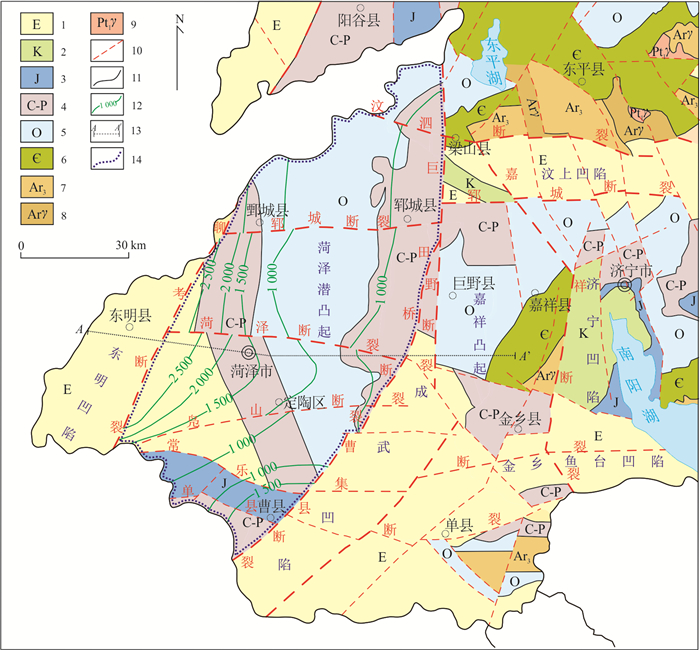
 下载:
下载:
